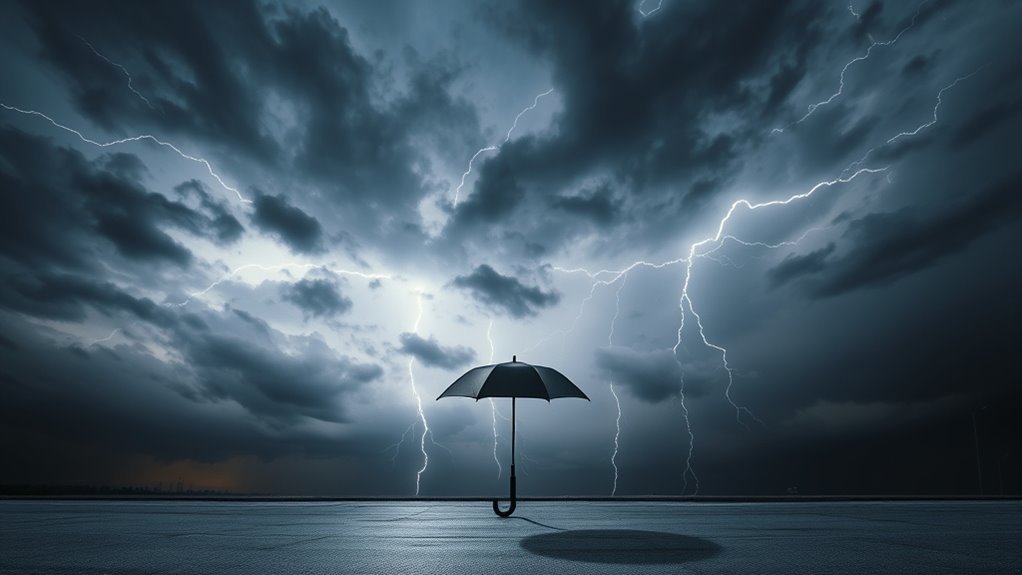Rain squalls and snow squalls are intense weather events impacting visibility and travel. Rain squalls occur in warmer conditions, leading to sudden heavy rainfall that can cause localized flooding. In contrast, snow squalls happen during colder temperatures, producing brief but intense snowfall that creates slippery roads and whiteout conditions. Both squalls can reduce visibility dramatically and challenge drivers. Understanding these key differences and their effects is essential for safety in severe weather situations. More perspectives await on this topic.
Main Points
- Rain squalls produce intense rainfall in warmer conditions, while snow squalls generate heavy snowfall in colder temperatures.
- Both squalls significantly reduce visibility, but rain squalls can cause hydroplaning, whereas snow squalls create icy road conditions.
- Rain squalls can lead to localized flooding, while snow squalls may result in road closures due to hazardous travel conditions.
- Safety tips for rain squalls include staying indoors and using headlights, while snow squalls require seeking shelter and stocking vehicles with emergency supplies.
- Both types of squalls necessitate emergency preparedness, including communication plans and accessible emergency kits for quick response.
Understanding Rain Squalls
Rain squalls are sudden, intense bursts of rainfall that can occur with little warning. These weather phenomena typically accompany strong thunderstorms or frontal systems, leading to brief periods of heavy precipitation.
Often defined by dark clouds, they can reduce visibility and create hazardous driving conditions. The intense nature of rain squalls can result in rapid accumulation of water, leading to localized flooding in susceptible areas.
The duration of rain squalls is usually short, often lasting from a few minutes to an hour. Despite their brevity, the intensity can catch individuals off guard, prompting the need for caution.
Weather forecasts and radar technology are essential for detecting these squalls, allowing people to prepare for potential impacts. Understanding rain squalls is vital for mitigating risks associated with sudden downpours and ensuring safety during inclement weather.
Characteristics of Snow Squalls

Snow squalls are intense, short-lived bursts of snowfall that can drastically reduce visibility and create treacherous travel conditions. Typically lasting less than an hour, these phenomena can produce sudden and heavy snowfall, leading to rapid accumulation on roadways. The snowfall intensity can exceed one inch per hour, which can catch drivers off guard and create hazardous driving situations.
Snow squalls often occur in conjunction with strong cold fronts, where unstable air interacts with colder surface temperatures. They can develop quickly, sometimes with little warning, making them particularly dangerous.
Wind gusts associated with snow squalls can exacerbate conditions by creating whiteout scenarios, further impairing visibility. The temperature drop accompanying a snow squall can also lead to the formation of ice on roads.
Generally, snow squalls present notable challenges for travelers and necessitate heightened awareness and caution in affected areas.
Key Differences Between Rain and Snow Squalls
Rain and snow squalls exhibit distinct characteristics primarily influenced by temperature variations and the types of precipitation they produce.
Rain squalls typically occur in warmer conditions, resulting in liquid precipitation, while snow squalls manifest in colder temperatures, leading to snowfall.
Understanding these differences is essential for predicting weather impacts and preparing for varying conditions.
Temperature Variations
While both rain and snow squalls can occur in similar weather conditions, the temperature variations that accompany each phenomenon are essential in distinguishing them.
Rain squalls typically manifest when temperatures are above freezing, leading to brief but intense downpours that can rapidly reduce visibility. In contrast, snow squalls occur when temperatures are at or below freezing, creating hazardous conditions with heavy snowfall.
- Chilling winds that bite through layers of clothing.
- Frosty air that transforms settings into winter wonderlands.
- Sudden drops in temperature that create a stark contrast to warmer periods.
These temperature differences not only influence the type of precipitation but also the comprehensive impact on the environment and safety for those caught in these weather events.
Precipitation Types
The differences in precipitation types during squalls are substantial, with rain and snow each presenting unique traits and impacts.
Rain squalls typically involve intense, short bursts of liquid precipitation, defined by rapid accumulation that can lead to localized flooding. This type of squall often occurs in warmer conditions, allowing for considerable evaporation and moisture retention.
In contrast, snow squalls feature heavy, falling snow that can greatly reduce visibility and create hazardous travel conditions. The snowfall from these squalls can accumulate quickly, resulting in snow-covered terrains and icy roads.
While both types can occur suddenly and with little warning, the effects of rain and snow squalls differ markedly, influencing safety measures and preparedness for affected regions.
Impact on Visibility and Travel

Rain and snow squalls greatly affect visibility and travel conditions.
These sudden weather events can lead to reduced visibility, resulting in travel disruptions and delays.
Consequently, drivers must implement safety precautions to steer through the hazardous conditions effectively.
Reduced Visibility Conditions
Reduced visibility during rain and snow squalls considerably impacts travel safety. Drivers often face challenges such as blurred vision and difficulty judging distances. This can lead to a heightened risk of accidents, as vehicles may unexpectedly appear or disappear from view.
The conditions can change rapidly, making it difficult for motorists to adjust to the environment.
- Fog-like curtains of rain obscuring the road ahead
- Swirling snowflakes transforming familiar terrains into whiteouts
- Tail lights of vehicles appearing as distant, flickering signals in the haze
These elements create a dangerous atmosphere that necessitates heightened caution and reduced speed, emphasizing the need for vigilance in such weather conditions.
Travel Disruptions and Delays
Although both rain and snow squalls can markedly disrupt travel, their impacts vary in severity and nature.
Rain squalls often result in sudden downpours that can lead to hydroplaning and reduced traction on roadways. Visibility can be greatly impaired, causing drivers to slow down or stop altogether, resulting in traffic congestion and delays.
Conversely, snow squalls introduce challenges associated with slippery surfaces and whiteout conditions. The rapid accumulation of snow can lead to hazardous driving environments, prompting road closures and extended delays.
Both types of squalls can strain transportation networks, affecting public transit schedules and causing logistical complications for freight and delivery services.
In the end, whether rain or snow, squalls can create considerable obstacles for travelers during inclement weather.
Safety Precautions Required
When facing squalls, whether rain or snow, travelers must prioritize safety precautions due to the considerable impact on visibility and road conditions.
In these challenging weather conditions, it is essential to remain vigilant and take proactive measures to guarantee personal safety and the safety of others on the road.
- Drive at reduced speeds, allowing more time to react to sudden changes.
- Use headlights, enhancing visibility for both the driver and other motorists.
- Maintain a safe distance from other vehicles, preventing collisions caused by slippery surfaces.
Safety Tips for Rain Squalls

As rain squalls can occur suddenly and with little warning, it is vital for individuals to take proactive safety measures. When a rain squall is forecasted, it is advisable to stay indoors and avoid unnecessary travel.
Drivers should be particularly vigilant, as heavy rain can impair visibility and create hazardous road conditions. Slowing down and using headlights can greatly improve safety during these events.
If caught outside, individuals should seek shelter to avoid potential lightning strikes or flash flooding. It is essential to remain informed through weather alerts and updates to guarantee timely responses to sudden changes in weather conditions.
Additionally, securing loose outdoor items can prevent them from becoming dangerous projectiles in strong winds. By adhering to these safety tips, individuals can markedly reduce the risks associated with rain squalls, protecting themselves and others from harm.
Safety Tips for Snow Squalls
Since snow squalls can develop rapidly and lead to sudden drops in visibility, it is crucial for individuals to take immediate safety precautions.
These weather events can create hazardous conditions that require vigilance, especially for those traveling or engaging in outdoor activities.
- Stay indoors: Seek shelter in a sturdy building to avoid exposure to harsh winds and freezing temperatures.
- Limit travel: If possible, postpone travel until conditions improve. If travel is unavoidable, remain alert for changing weather.
- Keep emergency supplies: Stock vehicles with essentials such as blankets, food, water, and a flashlight to guarantee safety during unexpected situations.
Preparing for Sudden Weather Changes
How can individuals effectively prepare for sudden weather changes?
To begin, staying informed is essential. Regularly checking weather forecasts and utilizing weather apps can provide timely alerts about impending squalls. Individuals should also create an emergency plan that includes safe shelter options and methods of communication with family members.
Stocking an emergency kit with essential supplies—such as water, non-perishable food, a flashlight, and first-aid items—ensures readiness in adverse conditions.
It is advisable to keep vehicles equipped with winter gear, such as blankets, ice scrapers, and extra fuel, especially in regions prone to snow squalls.
Additionally, individuals should develop a habit of dressing in layers and having appropriate outerwear accessible to quickly adjust to temperature fluctuations.
Common Questions
How Do Rain Squalls Form in Different Climates?
Rain squalls form through various atmospheric conditions, often involving moisture-laden air, temperature contrasts, and localized lifting mechanisms. These factors, combined with regional climate characteristics, influence the frequency and intensity of squall events in different environments.
Can Rain Squalls Occur in Winter?
Rain squalls can indeed occur in winter, particularly in milder areas where temperatures are above freezing. These events may bring brief, intense rain showers, contrasting with typical winter precipitation in colder regions, such as snow.
Are There Any Warning Systems for Squalls?
Warning systems for squalls exist, utilizing meteorological technology to monitor conditions. Alerts are issued through various channels, including weather apps and local broadcasts, ensuring that individuals are informed about impending squall events to improve safety.
How Can Squalls Affect Outdoor Events?
Squalls can greatly disrupt outdoor events, causing sudden weather changes that lead to dangerous conditions. Participants may face reduced visibility, increased risks of injury, and potential cancellations, all of which can impact total event success and enjoyment.
What's the Typical Duration of a Squall?
The typical duration of a squall varies but often lasts between 30 minutes to a few hours. Factors such as atmospheric conditions and geographical location can influence the length and intensity of these weather phenomena.

